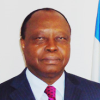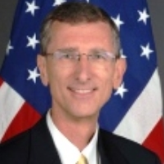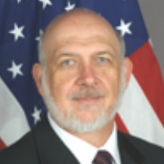Central African Republic
 Moussa-kembe, Stanislas
Moussa-kembe, Stanislas
On November 4, 2009, Stanislas Moussa-Kembe presented his credentials as ambassador of the Central African Republic (CAR) to the United States to President Barack Obama. It is the second ambassadorial posting for Moussa-Kembe; he previously served as emissary to the Democratic Republic of the Congo. Since June 2010, Moussa-Kembe has also served as his nation’s non-resident ambassador to Canada.
Moussa-Kembe was born December 9, 1949, in Bangassou in the southeastern part of the French colony that would become the Central African Republic (CAR). He attended church schools and later earned a degree in public administration.
Moussa-Kembe joined the CAR’s ministry of foreign affairs in 1976. He served stints as first secretary in his country’s embassies in Belgrade, Yugoslavia; and in Paris. Back home, Moussa-Kembe had positions as inspector of diplomatic missions and served on three different occasions as the CAR’s chief of protocol. When serving in that post in 2004, he helped facilitate the move to Jamaica of deposed Haitian President Jean-Bertrand Aristide, who had taken refuge in the Central African Republic after a coup earlier that year.
Since December 2012, the CAR has been wracked by civil war and sectarian massacres. Moussa-Kembe was first appointed as ambassador to the U.S. by President François Bozizé, who fled his country in March 2013. Since that time, Moussa-Kembe has remained in North America and kept a relatively low profile.
Moussa-Kembe is a widower and has 10 children.
-Steve Straehley
- Table of Contents
- News
- Overview
- Basic Information
- History
- Newspapers
- History of U.S. Relations with Central African Republic
- Current U.S. Relations with Central African Republic
- Where Does the Money Flow
- Controversies
- Human Rights
- Debate
- Past Ambassadors
- Ambassador to the U.S.
- Embassy Web Site in the U.S.
- Comments
- Leave a comment
U.S. Ambassador to Central African Republic

Laurence D. Wohlers was sworn in as U.S. Ambassador to the Central African Republic (CAR) on September 8, 2010.
Previous U.S. Ambassador to Central African Republic

Table of Contents
- News
- Overview
- Basic Information
- History
- Newspapers
- History of U.S. Relations with Central African Republic
- Current U.S. Relations with Central African Republic
- Where Does the Money Flow
- Controversies
- Human Rights
- Debate
- Past Ambassadors
- Ambassador to the U.S.
- Embassy Web Site in the U.S.
- Comments
- Leave a comment
 Moussa-kembe, Stanislas
Moussa-kembe, Stanislas
On November 4, 2009, Stanislas Moussa-Kembe presented his credentials as ambassador of the Central African Republic (CAR) to the United States to President Barack Obama. It is the second ambassadorial posting for Moussa-Kembe; he previously served as emissary to the Democratic Republic of the Congo. Since June 2010, Moussa-Kembe has also served as his nation’s non-resident ambassador to Canada.
Moussa-Kembe was born December 9, 1949, in Bangassou in the southeastern part of the French colony that would become the Central African Republic (CAR). He attended church schools and later earned a degree in public administration.
Moussa-Kembe joined the CAR’s ministry of foreign affairs in 1976. He served stints as first secretary in his country’s embassies in Belgrade, Yugoslavia; and in Paris. Back home, Moussa-Kembe had positions as inspector of diplomatic missions and served on three different occasions as the CAR’s chief of protocol. When serving in that post in 2004, he helped facilitate the move to Jamaica of deposed Haitian President Jean-Bertrand Aristide, who had taken refuge in the Central African Republic after a coup earlier that year.
Since December 2012, the CAR has been wracked by civil war and sectarian massacres. Moussa-Kembe was first appointed as ambassador to the U.S. by President François Bozizé, who fled his country in March 2013. Since that time, Moussa-Kembe has remained in North America and kept a relatively low profile.
Moussa-Kembe is a widower and has 10 children.
-Steve Straehley
Comments
U.S. Ambassador to Central African Republic

Laurence D. Wohlers was sworn in as U.S. Ambassador to the Central African Republic (CAR) on September 8, 2010.
Previous U.S. Ambassador to Central African Republic








Comments